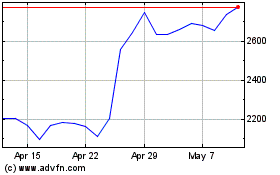BHP and others raise dividends, lower debt as commodity prices
stage sharp rebound
By Scott Patterson
This article is being republished as part of our daily
reproduction of WSJ.com articles that also appeared in the U.S.
print edition of The Wall Street Journal (August 23, 2017).
LONDON -- The world's biggest miners are on a tear.
Fueled by a sharp rise in commodities prices, companies like BHP
Billiton Ltd., Glencore PLC and Rio Tinto PLC are flush with cash
again, boosting dividends, cutting debt and shelling out cash for
expansion projects. Just a couple of years ago, they were
scrambling to survive in the midst of a historic downturn.
The world's biggest mining company, BHP, reported Tuesday a net
profit of $5.9 billion for the 12 months ended June 30. That is a
sharp turnaround from the previous year's loss of $6.4 billion,
when the company took big charges from U.S. oil-and-gas business
and a fatal 2015 dam failure at an iron-ore operation in
Brazil.
BHP boosted its annual dividend by 177% and said its net debt
had fallen 38% from the previous year to $16.3 billion.
BHP's report caps a strong string of financial results for
mining giants such as Rio Tinto, Anglo American PLC and
Glencore.
An important sign of these companies' renewed health is their
falling debt load. As of June, BHP, Rio Tinto, Anglo and Glencore
collectively held net debt of about $44 billion, down about 50%
from the end of 2014, according to a review of their earnings
reports.
It's a dramatic shift from two years ago, when the mining
industry was reeling. Slowing Chinese growth had sent commodity
prices sharply lower. Miners loaded up with debt and cut dividends
as their share prices sank.
But a surprise rally in the past year in major commodities such
as copper, iron ore and coal has been a windfall, bringing in much
needed cash, breathing new life into the beleaguered industry and
sparking a rally in mining stocks. The S&P 500 Metals &
Mining index has doubled since bottoming in January 2016.
The question for investors is whether miners will continue to
pay down debt -- and boost dividends -- or, lured by rising
commodity prices, return to the big-spending ways that got them
into trouble two years ago.
Paul Gait, a Bernstein mining-industry analyst, said the rally
has returned companies to the financial position they held before
the commodity-price bust but not further. That suggests the
companies remain shellshocked after the share-price collapse two
years ago and are unlikely to launch aggressive spending plans any
time soon.
"I don't think management wants to live through the volatility
that we saw in the last few years and the near-death experience
many of these companies saw," Mr. Gait said.
That is likely bullish for commodity prices in the long run, he
said, since it means few new large-scale mines are likely to get
started in the coming years, limiting the supply of materials like
copper even as demand rises.
To be sure, other miners aren't standing still. Rio Tinto is
plowing billions into a giant Mongolian copper mine and is moving
ahead on a big bauxite and iron-ore project in Australia. BHP last
week said it would spend $2.5 billion to extend the life of a
copper mine in Chile.
Indeed, copper and a byproduct of copper mining, cobalt, have
become darlings of the industry as miners position themselves for
what many describe as the next wave of development in China and
other industrializing countries. Such countries are likely to scale
back demand for bulk commodities such as iron ore and coal, used in
steel making, and shift to copper, used in electric grids and
consumer products such as washing machines and cars. Cobalt is a
key ingredient in lithium-ion batteries that power mobile phones
and electric vehicles.
"We should see strength in demand for those commodities as
economies grow toward the later cycle," Glencore Chief Executive
Ivan Glasenberg said on a recent conference call.
The trend away from developing so-called greenfield mines marks
a reverse from the so-called commodity supercycle, when surging
prices fueled by seemingly bottomless demand in China encouraged
miners' managements to splurge on new projects -- and the debt that
funded them. BHP in 2011, which posted a record $24 billion in net
profit, had plans to invest $20 billion in major projects and
exploration over the following year, and more than $80 billion by
2015. Rio planned to invest $14 billion in new projects in
2012.
Hunter Hillcoat, a mining analyst at Investec Securities, says
there is one exception to miners' more-cautious stance: Glencore.
The Swiss mining giant has been more focused on deal-making than
its competitors, inking a $1.1 billion deal in July for a stake in
Australian coal assets and mulling a bid for $11 billion grain
trader Bunge Ltd.
While Glencore has restored its dividend, returning $1 billion
to shareholders in 2017, it didn't announce an increase in the
payout in its latest earnings report this month as did BHP and Rio.
Anglo American surprised investors by reinstating the dividend
after having suspended it in 2015.
That's fine with David Herro, fund manager for Harris Associates
LP, which controls about 5% of Glencore's stock valued about $3
billion, according to FactSet. A year ago, Mr. Herro wanted Mr.
Glasenberg to hold his fire on the deal-making front and focus on
restoring the company's balance sheet after its faced down a
share-price collapse in 2015.
That's changed.
"They are very astute deal makers," Mr. Herro said.
Write to Scott Patterson at scott.patterson@wsj.com
(END) Dow Jones Newswires
August 23, 2017 02:47 ET (06:47 GMT)
Copyright (c) 2017 Dow Jones & Company, Inc.
Anglo American (LSE:AAL)
Historical Stock Chart
From Mar 2024 to Apr 2024

Anglo American (LSE:AAL)
Historical Stock Chart
From Apr 2023 to Apr 2024
